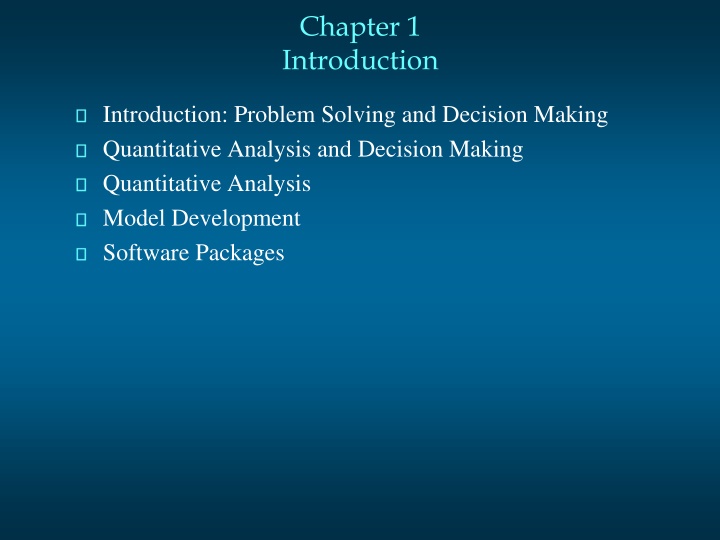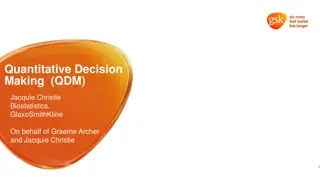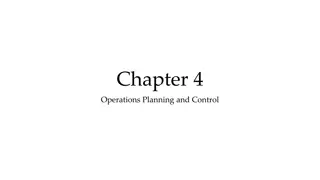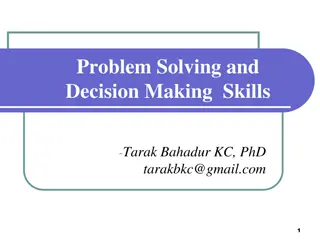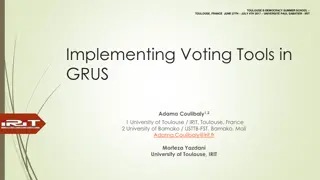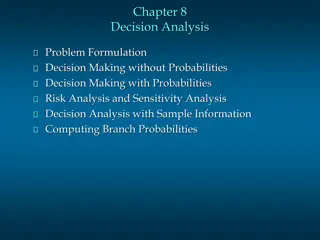Introduction to Quantitative Decision Making
Delve into the realm of quantitative analysis and decision-making, exploring the use of mathematical models and software tools to tackle complex problems. Understand the process of structuring, analyzing, and solving problems, incorporating both qualitative judgment and quantitative data. Discover the significance of operations research and management science in modern business and industry landscapes.
Download Presentation

Please find below an Image/Link to download the presentation.
The content on the website is provided AS IS for your information and personal use only. It may not be sold, licensed, or shared on other websites without obtaining consent from the author.If you encounter any issues during the download, it is possible that the publisher has removed the file from their server.
You are allowed to download the files provided on this website for personal or commercial use, subject to the condition that they are used lawfully. All files are the property of their respective owners.
The content on the website is provided AS IS for your information and personal use only. It may not be sold, licensed, or shared on other websites without obtaining consent from the author.
E N D
Presentation Transcript
Chapter 1 Introduction Introduction: Problem Solving and Decision Making Quantitative Analysis and Decision Making Quantitative Analysis Model Development Software Packages
Operations Research The body of knowledge involving quantitative approaches to decision making is referred to as Management Science Operations Research Decision Science It had its early roots in World War II and is flourishing in business and industry due, in part, to: numerous methodological developments (e.g. simplex method for solving linear programming problems) a virtual explosion in computing power
Quantitative Analysis and Decision Making Decision-Making Process Structuring the Problem Analyzing the Problem Define the Problem Identify the Alternatives Determine the Criteria Identify the Alternatives Choose an Alternative
Quantitative Analysis and Decision Making Analysis Phase of Decision-Making Process Qualitative Analysis based largely on the manager s judgment and experience includes the manager s intuitive feel for the problem is more of an art than a science
Quantitative Analysis and Decision Making Analysis Phase of Decision-Making Process Quantitative Analysis analyst will concentrate on the quantitative facts or data associated with the problem analyst will develop mathematical expressions that describe the objectives, constraints, and other relationships that exist in the problem analyst will use one or more quantitative methods to make a recommendation
Quantitative Analysis and Decision Making Potential Reasons for a Quantitative Analysis Approach to Decision Making The problem is complex. The problem is very important. The problem is new. The problem is repetitive.
Quantitative Analysis Quantitative Analysis Process Model Development Data Preparation Model Solution Report Generation
Model Development Models are representations of real objects or situations Three forms of models are: Iconic models - physical replicas (scalar representations) of real objects Analog models - physical in form, but do not physically resemble the object being modeled Mathematical models - represent real world problems through a system of mathematical formulas and expressions based on key assumptions, estimates, or statistical analyses
Advantages of Models Generally, experimenting with models (compared to experimenting with the real situation): requires less time is less expensive involves less risk The more closely the model represents the real situation, the accurate the conclusions and predictions will be.
Example: Production Problem (1) The total profit from the sale of a product can be determined by multiplying the profit per unit by the quantity sold. If we let x represent the number of units sold and P the total profit, then, with a profit of $10 per unit, the following mathematical model defines the total profit earned by selling x units The above mathematical expression describes the problem s objective and the firm will attempt to maximize profit.
Example: Production Problem (2) A production capacity constraint would be necessary if, for instance, 5 hours are required to produce each unit and only 40 hours of production time are available per week. The production time constraint is given by The value of 5x is the total time required to produce x units; the symbol indicates that the production time required must be less than or equal to the 40 hours available
Example: Production Problem (3) The decision problem or question is the following: How many units of the product should be scheduled each week to maximize profit? A complete mathematical model for this simple production problem is This model is an example of a linear programming model.
Mathematical Models Objective Function a mathematical expression that describes the problem s objective, such as maximizing profit or minimizing cost Constraints a set of restrictions or limitations, such as production capacities Uncontrollable Inputs environmental factors that are not under the control of the decision maker Decision Variables controllable inputs; decision alternatives specified by the decision maker, such as the number of units of Product X to produce
Mathematical Models Deterministic Model if all uncontrollable inputs to the model are known and cannot vary Stochastic (or Probabilistic) Model if any uncontrollable are uncertain and subject to variation Stochastic models are often more difficult to analyze. Frequently a less complicated (and perhaps less precise) model is more appropriate than a more complex and accurate one due to cost and ease of solution considerations.
Transforming Model Inputs into Output Uncontrollable Inputs (Environmental Factors) Controllable Inputs (Decision Variables) Output (Projected Results) Mathematical Model
Example: Iron Works, Inc. Iron Works, Inc. manufactures two products made from steel and just received this month's allocation of b pounds of steel. It takes a1 pounds of steel to make a unit of product 1 and a2 pounds of steel to make a unit of product 2. Let x1 and x2 denote this month's production level of product 1 and product 2, respectively. Denote by p1 and p2 the unit profits for products 1 and 2, respectively. Iron Works has a contract calling for at least m units of product 1 this month. The firm's facilities are such that at most u units of product 2 may be produced monthly.
Example: Iron Works, Inc. Mathematical Model The total monthly profit = (profit per unit of product 1) x (monthly production of product 1) + (profit per unit of product 2) x (monthly production of product 2) = p1x1 + p2x2 We want to maximize total monthly profit: Max p1x1 + p2x2
Example: Iron Works, Inc. Mathematical Model (continued) The total amount of steel used during monthly production equals: (steel required per unit of product 1) x (monthly production of product 1) + (steel required per unit of product 2) x (monthly production of product 2) = a1x1 + a2x2 This quantity must be less than or equal to the allocated b pounds of steel: a1x1 + a2x2 < b
Example: Iron Works, Inc. Mathematical Model (continued) The monthly production level of product 1 must be greater than or equal to m : x1 > m The monthly production level of product 2 must be less than or equal to u : x2 < u However, the production level for product 2 cannot be negative: x2 > 0
Example: Iron Works, Inc. Mathematical Model Summary Max p1x1 + p2x2 s.t. a1x1 + a2x2 < b x1 > m x2 < u x2 > 0 Constraint s Objectiv e Function Subject to
Example: Iron Works, Inc. Question: p1 = 100, p2 = 200. Rewrite the model with these specific values for the uncontrollable inputs. Suppose b = 2000, a1 = 2, a2 = 3, m = 60, u = 720,
Example: Iron Works, Inc. Answer: Substituting, the model is: s.t. 2x1 + 3x2 < 2000 x1 > 60 x2 < 720 x2 > 0 Max 100x1 + 200x2
Example: Iron Works, Inc. Question: and x2 = 626 2/3. If the product were engines, explain why this is not a true optimal solution for the "real-life" problem. Answer: One cannot produce and sell 2/3 of an engine. Thus the problem is further restricted by the fact that both x1 and x2 must be integers. (They could remain fractions if it is assumed these fractions are work in progress to be completed the next month.) The optimal solution to the current model is x1 = 60
Example: Iron Works, Inc. Uncontrollable Inputs $100 profit per unit Prod. 1 $200 profit per unit Prod. 2 2 lbs. steel per unit Prod. 1 3 lbs. Steel per unit Prod. 2 2000 lbs. steel allocated 60 units minimum Prod. 1 720 units maximum Prod. 2 0 units minimum Prod. 2 Max 100(60) + 200(626.67) s.t. 2(60) + 3(626.67) < 2000 60 > 60 626.67 < 720 626.67 > 0 60 units Prod. 1 626.67 units Prod. 2 Profit = $131,333.33 Steel Used = 2000 Output Controllable Inputs Mathematical Model
Linear Programming (LP) Problems MAX (or MIN): c1X1 + c2X2+ + cnXn Subject to: a11X1 + a12X2+ + a1nXn <= b1 ak1X1 + ak2X2+ + aknXn >=bk am1X1 + am2X2+ + amnXn = bm : :
An Example LP Problem Blue Ridge Hot Tubs produces two types of hot tubs: Aqua-Spas & Hydro-Luxes. Aqua-Spa Pumps 1 Labor 9 hours Tubing 12 feet Unit Profit $350 Hydro-Lux 1 6 hours 16 feet $300 There are 200 pumps, 1566 hours of labor, and 2880 feet of tubing available.
Steps In Formulating LP Models: 1. Understand the problem. 2. Identify the decision variables. X1=number of Aqua-Spas to produce X2=number of Hydro-Luxes to produce 3. State the objective function as a linear combination of the decision variables. MAX: 350X1 + 300X2
Steps In Formulating LP Models (continued) 4. State the constraints as linear combinations of the decision variables. 1X1 + 1X2 <= 200 } pumps 9X1 + 6X2 <= 1566 12X1 + 16X2 <= 2880 5. Identify any upper or lower bounds on the decision variables. X1 >= 0 X2 >= 0 } labor } tubing
LP Model for Blue Ridge Hot Tubs MAX: 350X1 + 300X2 S.T.: 1X1 + 1X2 <= 200 9X1 + 6X2 <= 1566 12X1 + 16X2 <= 2880 X1 >= 0 X2 >= 0
Solving LP Problems: An Intuitive Approach Idea: Each Aqua-Spa (X1) generates the highest unit profit ($350), so let s make as many of them as possible! How many would that be? Let X2 = 0 1st constraint: 1X1 <= 200 2nd constraint: 9X1 <=1566 or X1 <=174 3rd constraint: 12X1 <= 2880 or X1 <= 240 If X2=0, the maximum value of X1 is 174 and the total profit is $350*174 + $300*0 = $60,900 This solution is feasible, but is it optimal? No!
